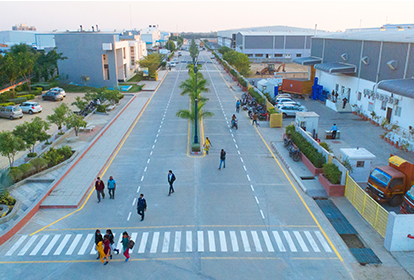
Civil Infrastructure Engineering for Greenfield Industrial Projects
General Introduction
Civil and infrastructure engineering play a pivotal role in the successful execution of Greenfield industrial projects. The Greenfield industrial projects involve the development of entirely new industrial facilities, such as manufacturing units and factories, on previously undeveloped land. Proper civil design and systematic planning are of utmost importance to ensure the efficiency, safety, and sustainability of such construction projects. This article explores various site-level civil design aspects that are important for the success of greenfield industrial construction projects, including landfilling, cutting, and grading, storm water management; roads and pavement design; utility road crossings; pipe and box culverts; and underground utilities.
Landfilling/Cutting/Grading
One of the primary steps in developing a Greenfield industrial project is the preparation of the construction site. This typically involves activities such as landfilling, cutting, and grading the land to create a suitable platform for the construction of the structure. Proper grading ensures that the site is level and in a stable condition, minimizing the risk of issues like settlement in the future. Landfilling and cutting activities must be performed precisely to achieve the desired elevation and slopes. This is of vital importance for the construction of buildings, roads, and other infrastructure components.
Storm water Management
Effective storm water management is essential to prevent erosion, flooding, and contamination of the water bodies present in the nearby surroundings. Greenfield construction projects often require the implementation of storm water retention ponds, swales, and detention basins to control surface runoff and ensure compliance with environmental regulations. Construction engineers must carefully plan and design these systems to account for the local climate and the volume of water generated during heavy rainfall events.
Roads and Pavement Design
Roads within an industrial construction site are the lifelines that connect different areas, such as production facilities, warehouses, and administrative offices. An appropriate road design is crucial to ensure smooth traffic flow and to accommodate heavy industrial equipment and machinery. The construction engineers must consider factors like pavement type, thickness, and load-bearing capacity when designing roads. Moreover, a properly designed road section should include the right of way for future expansion and upgrades.
Utility Road Crossings
Greenfield industrial projects often require the installation of utilities such as water lines, gas pipelines, electrical cables, and communication lines. These utilities may need to cross roads within the industrial site. Systematic planning and design are essential to ensure that utility road crossings are constructed safely and do not interfere with traffic or road integrity. The utilization of chambers or conduit systems for utilities can help streamline these crossings.
Pipe/Box Culverts
In areas where natural drainage pathways or water bodies intersect the construction site, civil engineers must design and install pipe or box culverts. These structures enable water to flow under roads and other infrastructure, preventing flooding and maintaining the integrity of the industrial construction site. Proper sizing and placement of culverts are essential to confirm the efficient movement of water and prevent erosion or structural damage.
Laying of Underground Utilities
The efficient operation of any industrial facility depends on a complex network of underground utilities, which includes electrical cables, water pipes, sewer lines, and data communication cables. Construction engineers, architects, and planners must carefully plan the layout of these utilities to ensure accessibility for maintenance and minimize the risk of damage during construction or future development. Proper trenching, backfilling, and protection measures are critical.
Wrapping Up
Civil infrastructure engineering is the backbone of Greenfield industrial projects. Appropriate site preparation, storm water management, roads and pavement design, utility road crossings, pipe/box culverts, and underground utilities are vital components of successful project execution. Engineers must collaborate closely with environmental experts, geotechnical engineers, and other professionals to address the unique challenges and requirements of each industrial construction project. By prioritizing these civil design aspects, Greenfield industrial construction projects can achieve sustainability, safety, and efficiency, ultimately contributing to the success and longevity of the industrial facility.




